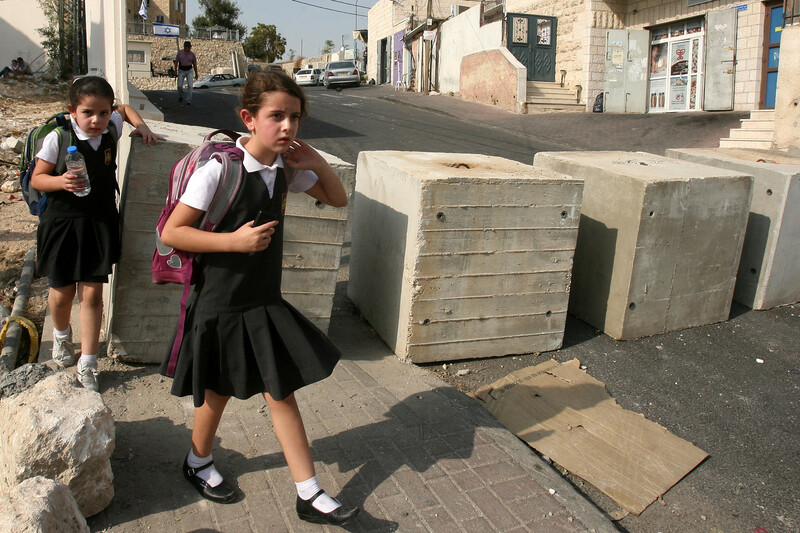Rights and Accountability 3 January 2016

Palestinian schoolgirls walk by cement roadblocks erected by Israeli forces in occupied East Jerusalem’s Jabal al-Mukabir neighborhood, 19 October 2015.
APA imagesEvery year, around 300 boys in the Jabal al-Mukabir neighborhood of occupied East Jerusalem complete middle school and are ready to advance to the next grade.
But fewer than half of them are able to find a spot in the only secondary school in the neighborhood, Sakhnin High School. Many just drop out altogether.
Looking for space in another area is not a solution. The shortage of classrooms available to students in Jabal al-Mukabir is replicated throughout the occupied city.
Israel has militarily occupied East Jerusalem since June 1967 and formally annexed it in 1980.
No country recognizes Israeli sovereignty and under international law its annexation of the city is null and void.
But under the Fourth Geneva Convention, which the UN Security Council has repeatedly stated applies to Israel, the occupying power is responsible for the welfare of the population it rules.
Classroom shortage
It is conservatively estimated that 2,247 new classrooms are needed to meet current shortages and replace existing substandard facilities for Palestinian students in East Jerusalem, according to a new report by Israeli human rights group Ir Amim.
That adds up to a need for school places for an estimated 80,000 students.
Ir Amim says that the dearth of classroom space is responsible for the fact that 36 percent of children in East Jerusalem do not complete a high school education.
In February 2011, following a decade of litigation, Israel’s high court ruled that the authorities’ neglect of Palestinian schools in Jerusalem violated their right to education.
The government and the Israeli-imposed Jerusalem municipality were given five years to correct the enormous gap between the need for and availability of official education facilities for Palestinians.
But with the deadline nearly reached, it is clear from Ir Amim’s report that the gulf remains as wide as ever.
“The gaps reviewed in this report have intolerable repercussions for tens of thousands of children,” Ir Amim states. These children “have no place in the official educational system and are forced to study in recognized but unofficial institutions.”
Since 2001, the number of students attending schools that fall under this status, including Sakhnin High School, has multiplied by a factor of 22, while the number enrolled in official schools has grown a modest 40 percent.
Recognized but unofficial schools receive some education ministry funding but are privately operated, charge tuition fees and are far inferior to official schools, according to Ir Amim. They are frequently located in overcrowded buildings and lack basic facilities such as air-conditioning, heating, laboratories and libraries.
Ir Amim calls the rising number of students in such schools alarming. Their rapid increase is a reflection of the desperate need for more classrooms than the municipality and the Israeli education ministry provide, not student or parental preference.
At the beginning of the academic year in 2015, parents in Jabal al-Mukabir refused to send their children to Sakhnin due to the substandard quality of education.
Ir Amin notes that parents in the neighborhood have been very active in advocating for better facilities for their children. In July 2015, a group of parents filed a lawsuit against the Israeli authorities for their refusal to open a school for boys in the neighborhood.
Of 105,000 Palestinian students in school in East Jerusalem, 42 percent are in official schools, 42 percent are in recognized but unofficial schools and the remaining 16 percent are in private schools.
However, there are at least 127,000 Palestinian children of school age in East Jerusalem, which means that the educational status of 22,000 children is unknown.
Highest dropout rate
The neglect of education in East Jerusalem has led to Palestinians there having the highest dropout rate anywhere in historic Palestine.
Palestinian children in East Jerusalem have a dropout rate of 13 percent, more than twice the rate for Palestinian citizens in present-day Israel.
The dropout rate for male and female secondary students in the Israeli-occupied West Bank and Gaza Strip, where education is run by the Palestinian Authority and UN agencies, is about 2.5 percent, according to the United Nations Development Programme.
West Jerusalem, the part of the city that became overwhelmingly Jewish as a result of the 1948 ethnic cleansing of its Palestinian population by Zionist militias, has a dropout rate of just one percent and boasts 21 programs dedicated to dropout prevention.
East Jerusalem, which is still predominantly Palestinian despite Israel’s ongoing efforts to ethnically cleanse it through home demolitions, colonization and revocation of residency rights, has a mere eight such programs – due to a lack of funds.
In 2014 the Israeli government decided to invest in the socioeconomic development of Jerusalem “for the benefit of all of its residents,” according to Ir Amim.
Yet the plan budgeted $24 million to police and just $12 million to education for all of Jerusalem. Nowhere does the scheme mention the severe shortage of classrooms for Palestinian children.
Ir Amim notes that 38 percent of the sum allocated for education was directed towards Israel’s efforts to assert its control over East Jerusalem in violation of the needs, wishes and rights of Palestinians there.
Discriminatory planning
And while 2015 saw the construction of more classrooms in East Jerusalem than in the previous 14 years combined, the number of new classrooms built since 2001 is still only half of what is needed merely to keep up with population growth.
While Ir Amim does not expand on the reasons why Israeli authorities have failed to meet their court-ordered obligations, Israel’s longstanding discriminatory planning policies certainly offer a partial explanation.
In 1975, Yisrael Kimhi, a senior interior ministry official, explained Israel’s plan for its newly conquered territory in East Jerusalem: “one of the cornerstones in the planning of Jerusalem is the demographic question.”
In other words, it became Israeli government policy to limit the growth of the Palestinian population in East Jerusalem while promoting Jewish settlement.
So while 38 percent of East Jerusalem’s planned areas have been confiscated for the development of Jewish settler neighborhoods, only 2.6 percent is zoned for public buildings – such as schools – for the city’s indigenous Palestinians.






Comments
Fleeing Germany
Permalink Donatus replied on
because being squeezed out of higher education in Nazi Germany, January 2 1939 to The Netherlands.
This was the fate of the Jewish boy Hajo G. Meyer (14) to be, later, deported to Auschwitz (rescued by the Soviets).
"Never should Jews do to others, what the Nazi had been done to us" was later PhD Hajo Meyer's lifetime self-commitment. He always was convinced that the crime against European Jews began with hindering of adequate schooling by the Nazi. Zionism finally broke him, Hajo died, disillusioned at the age of 90 August 12.2014 in Holland. R.I.P.